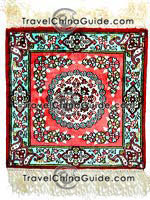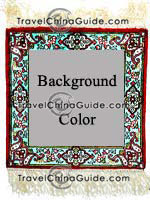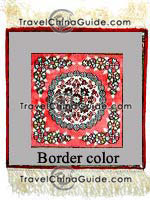Silk Carpet Layout, Foundation and Color
Layout
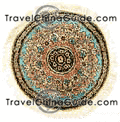 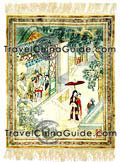 |
All-Over
Carpets in this layout have no central design and the designs spread throughout the carpet, separated or connected. There may be one design or several designs appearing repeatedly throughout the whole background. Sometimes designs will not stop repeating until the borders.
Medallion In this layout, a large centerpiece is the main design called medallion. And this layout is by far the most common one encountered in handmade carpets. The shapes of medallions are usually round, oval, diamond, octagonal, hexagonal and star-like. One-Sided In this layout, the designs are woven in only one direction. Therefore the carpet can only be properly viewed from one side. The designs on one-sided carpets are usually pictures of people, animals and scenery. Since one-sided carpets should not be viewed upside-down they are most often used as tapestries.
Foundation
In referring to ' foundation' we describe the basic components of a carpet. These are two in number, namely warp yarns and weft yarns. Usually the same fiber is used for both the warp and the weft and this can be either cotton or wool in handmade carpets. Cotton is most commonly used but wool will be used mostly in places where it is readily available. Silk is used for silk carpets and generally for those with silk piles. Though expensive, silk is highly favored as a foundation material because it is very strong.
Warp
Warp yarns are the vertical strands of fiber stretching from the top to the bottom of a carpet. They are an extremely important component because the knots (if knots are created) are tied to them and the weft yarns are woven through them. Basically if the warp yarns are not of even tension, a carpet will wrinkle.
Weft
From the above you can deduce that weft yarns are the horizontal strands. They are woven through the back and front warp yarns and added before or after the rows of knots, to prevent them from becoming loose.
Color
When choosing a carpet, color will be one of the most important elements you should consider. It is the first impression a carpet gives you and it is the contrast of various colors that creates the different designs. This is just the same in all other art fields, where the same rule applies.
The colors of a carpet are mainly identified by the background color and the border color. The background color is dominant. It usually covers the entire carpet with the exception of the border and the most commonly used colors are various shades of red, beige and yellow. However, there are examples where the background and the border are so distinguishable as colorful designs will always outweigh the less vibrant color of the border.
To produce fibers of various colors to create beautifully colored carpets, we need the dyeing process. There are two types of dye - natural and synthetic. Natural dyes are still used today in many carpet-producing areas where sources are readily available. Compared with natural dyes, synthetic dyes are easily obtained, to use and less expensive. In addition, synthetic dyeing is colorfast and can produce an infinite variety of colors. Sometimes both types are used in conjunction to make a carpet so as to attain the best appearance and quality.
Color Symbolism
In China and many oriental countries colors as well as designs have symbolic meanings, especially in the past. Traditional culture and religious belief affected much in carpet-making. For more information please read style.
Red, the most widely used color has the meaning of happiness and great joy; yellow, gold and purple are the colors mostly used by Chinese Royal Family and they indicate wealth, power and majesty; dark colors symbolize solitude. In other oriental countries, colors are also symbolic. In recent years, color symbolism is less important, although it can still apply. This is because producers are meeting the requirements of an expanding export market and adapting to the needs of customers, especially of western customers.
